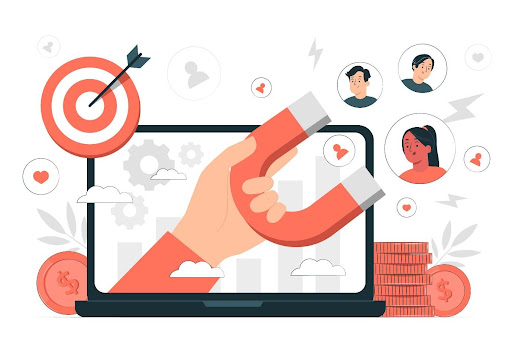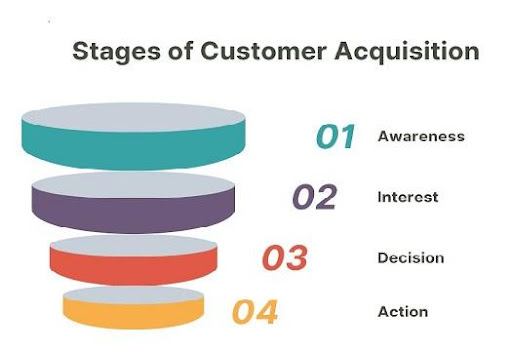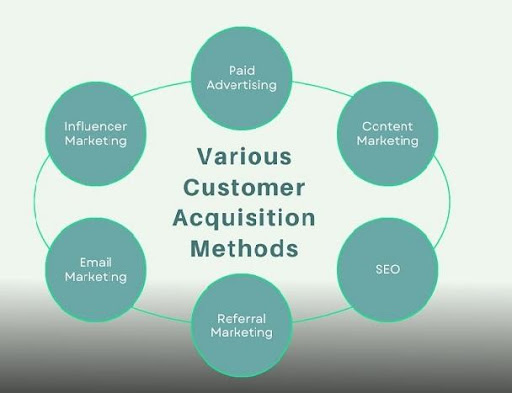Prasanna Chitanand
Senior SEO Specialist at Express Analytics. Has experience in SEO, Social Media, Blogging, Online Reputation Management, Google Ads, and YouTube Video Optimization.
Master the evolving customer acquisition landscape with 10 powerful strategies for 2023. Unlock actionable steps to enhance acquisition efforts and succeed in the competitive market.
In today's highly competitive business world, customer acquisition has become a critical aspect of every organization's growth strategy. Attracting and retaining customers is the goal of any business, and without a steady stream of new customers, it can be challenging to sustain growth and profitability.

The process of attracting and gaining new customers for a business is known as customer acquisition. It includes the implementation of a variety of strategies and techniques to attract potential clients, turn them into paying clients, and retain them for a long period.
The goal of customer acquisition is to increase a business's customer base and revenue. It typically involves marketing and advertising efforts, such as targeted advertising campaigns, search engine optimization, content marketing, social media marketing, and email marketing.
Effective customer acquisition requires a deep understanding of the target market, including their needs, preferences, and behaviors.
It also involves developing a compelling value proposition that sets a business apart from its competitors and provides customers with a clear reason to choose them.

To succeed in acquiring new customers, it's essential to understand the four key elements of customer acquisition. These are:
Identifying your target audience
The first step in customer acquisition is identifying your target audience. You need to know who your ideal customer is, what their needs and preferences are, and where they are most likely to be found.
This information will help you to create targeted marketing campaigns and reach your potential customers effectively.
Developing a value proposition
Your value proposition is what sets your business apart from your competitors. It's the reason why your customers should choose your business over others.
Developing a compelling value proposition requires a deep understanding of your target audience and their needs. Your value proposition should communicate the benefits of your products or services and how they can help your customers solve their problems or achieve their goals.
Creating an effective marketing strategy
An effective marketing strategy is essential for customer acquisition. Your marketing strategy should be tailored to your target audience and communicate your value proposition effectively.
It should include a mix of marketing channels, such as social media, email marketing, SEO, PPC, and content marketing, to reach your potential customers and generate leads.
Providing exceptional customer experience
Providing exceptional customer experience is critical for customer acquisition. If your customers have a positive experience, they are more likely to recommend your business to others.
This requires delivering high-quality products or services, providing excellent customer service, and addressing any issues or concerns promptly.
Both customer acquisition and marketing have different goals and processes. The objective of marketing is to increase brand value i.e., keeping your brand in front of your potential customers.
The objective of customer acquisition is to convince customers to take action. It involves the implementation of strategies that convinces users to become customer soon after knowing your brand.
Examples include clicking on the “Contact” button and filling out the form or entering credit card details after clicking on the “Signup” option.
Customer acquisition is a joint effort between sales and marketing teams. While marketing creates awareness and generates leads, sales teams are responsible for converting those leads into paying customers.
The four stages of customer acquisition are:
Awareness: This stage involves creating awareness about your product or service among potential customers. It typically includes advertising, content marketing, social media marketing, and other promotional activities.
Interest: Once potential customers become aware of your product or service, the next step is to generate interest in it. This involves providing more information about the product or service, highlighting its features and benefits, and answering any questions or concerns they may have.
Decision: At this stage, potential customers are considering whether to make a purchase or not. Sales teams typically play a critical role in helping customers decide by providing personalized guidance and addressing any objections or concerns.
Action: The final stage of customer acquisition is when the customer takes action and makes a purchase. This may involve completing an online transaction, signing a contract, or placing an order.
After the purchase, the focus shifts to customer retention, which involves ensuring that customers are satisfied and continue to do business with you.

The most challenging task for a business is to find out which customer acquisition methods work better for them. Listed below are the various customer acquisition methods that can help you get customers for your business:
Paid Advertising: Using paid advertising is a fast and effective way to reach a broad audience. Pay-per-click (PPC) advertising, social media advertising, and display advertising are some of the most common forms of paid advertising.
The key is to target your ads to your ideal customers and use compelling ad copy to entice them to click.
Content Marketing: Content marketing involves creating valuable content that educates, entertains, or informs your target audience. One way to achieve this is through various forms of content creation, such as social media updates, infographics, blog posts, and videos.
The goal is to attract potential customers to your website or social media pages and build trust and credibility with them over time.
Search Engine Optimization (SEO): Your website must be optimized for SEO to rank higher in SERPs. By ranking higher, your website will attract more organic traffic, which can lead to more customers. The key to successful SEO is to identify the right keywords and optimize your website's content and structure accordingly.
Referral Marketing: Encourage your current clients to recommend their friends and family to your business by using referral marketing. This can include offering incentives, such as discounts or free products or services, to customers who refer new business to you.
Email Marketing: Sending targeted emails to your subscribers helps you advertise your products and services. The key is to segment your email list and send personalized, relevant emails that are tailored to each subscriber's interests and needs.
Influencer Marketing: Partnering with influencers that have a large following on social media or other platforms is known as influencer marketing. The idea is to leverage their influence and reach to promote your products or services to their audience.
Offer a free trial: Offering a free trial is a great way to give potential customers a taste of what your product or service can offer. It can also help to build trust and credibility with your audience.
Use social media: Social media can be a powerful tool for customer acquisition. By creating engaging content and interacting with your followers, you can attract new customers and build relationships with your existing ones.
Create valuable content: Creating valuable content, such as blog posts, videos, and infographics, can help to attract potential customers to your website or social media pages. By providing value upfront, you can build trust and establish yourself as an authority in your industry.
Optimize your website: Optimizing your website for search engines can help to attract more organic traffic, which can lead to more customers. This can involve optimizing your website's structure, content, and metadata to rank higher in search engine results pages (SERPs).
Use email marketing: Email marketing can be a powerful tool for customer acquisition. By sending targeted emails to your subscribers, you can promote your products or services and build relationships with your audience.
Run a referral program: Referral programs can be a great way to incentivize your existing customers to refer new businesses to you. This can involve offering discounts, free products, or other rewards to customers who refer new customers to your business.
Use paid advertising: Paid advertising, such as PPC advertising and social media advertising, can be an effective way to reach a large audience quickly. The key is to target your ads to your ideal customers and use compelling ad copy to entice them to click.
Attend industry events: Attending industry events, such as conferences and trade shows, can be a great way to network with potential customers and build relationships with other businesses in your industry.
Partner with other businesses: Partnering with other businesses that serve your target market can be a great way to expand your reach and attract new customers.
Offer exceptional customer service: Offering exceptional customer service can help to build loyalty and attract new customers through word-of-mouth referrals. By going above and beyond to meet your customers' needs, you can build a loyal customer base that will continue to do business with you over time.
Various companies use different marketing strategies to acquire fresh customers and maintain present ones on a day-to-day basis. The truth is single marketing strategy may provide better results for certain businesses, doesn’t mean that it provides results for you also.
Let’s have a look at a few examples:
Amazon: Amazon uses varieties of customer acquisition techniques and provides different products at low and reasonable prices. Its fast delivery service has been an added advantage for many users. In addition, the company sends personalized emails to its users based on their preferences.
The best example is sending an email to inform them about products being present in their shopping cart.
Dropbox: This company uses a referral program as part of its strategy. They got inspired by Paypal, and offering a user a benefit in exchange for a referral is the best way for user acquisition. According to research, Dropbox has got 3.9 million fresh registered users.
HubSpot: HubSpot knows that the acquisition of customers is important for them to build a loyal customer base. So, they started posting tweets regarding their Academy to increase their website visitors.
Also, they grabbed the attraction of users by using the “Blog ideas generator”. There, a user needs to fill out the blank space with at least a single word to receive suggested blog titles.
Later, to get a complete list of blog post titles, a user has to create a new account as part of registration. This will lead to an increase in new customers, isn’t it a good idea.
Here are some key metrics and methods to consider when measuring customer acquisition:
Conversion Rate: Calculate the percentage of website visitors or leads who convert into paying customers. This metric helps measure the effectiveness of your marketing channels and campaigns in driving customer acquisition.
Cost per Acquisition (CPA): Determine the average cost incurred to acquire a new customer. By comparing the CPA with the customer's lifetime value, you can assess the profitability of your acquisition efforts.
Customer Acquisition Cost (CAC): This metric measures the total cost associated with acquiring a new customer, including marketing expenses, sales commissions, and other relevant costs. It provides insights into the financial investment required for each customer.
Return on Advertising Spend (ROAS): Analyze the revenue generated from your advertising campaigns relative to the advertising costs. ROAS helps evaluate the effectiveness of specific marketing channels and campaigns in driving customer acquisition.
Time to Acquisition: Measure the average time it takes for a prospect to convert into a customer. This metric provides insights into the efficiency of your sales and marketing processes and helps identify areas for improvement.
Referral Rate: Assess the percentage of new customers acquired through referrals from existing customers. A high referral rate indicates customer satisfaction and advocacy, contributing to organic customer acquisition.
Customer Lifetime Value (CLV): Determine the total revenue a customer is expected to generate over their lifetime as your customer. Understanding CLV helps prioritize customer acquisition efforts and allocate resources effectively.
It's essential to remember that customer acquisition is an ongoing process. You need to continually evaluate your strategies, test new approaches, and adjust your tactics based on the results. By staying up-to-date with the latest trends and technologies, you can stay ahead of the competition and achieve long-term success.
So, go ahead and implement these customer acquisition strategies for your business in 2023. With the right mindset and approach, you can attract new customers, grow your business, and achieve your goals.
You’ll also receive some of our best posts today

Senior SEO Specialist at Express Analytics. Has experience in SEO, Social Media, Blogging, Online Reputation Management, Google Ads, and YouTube Video Optimization.
Not all businesses have a documented content marketing strategy,...
The continuous improvement of email marketing tools has allowed...
Software as a Service, abbreviated as SaaS, is a...

User reviews are a game-changer for e-commerce. Consumers rely heavily o...
Don’t miss the new articles!